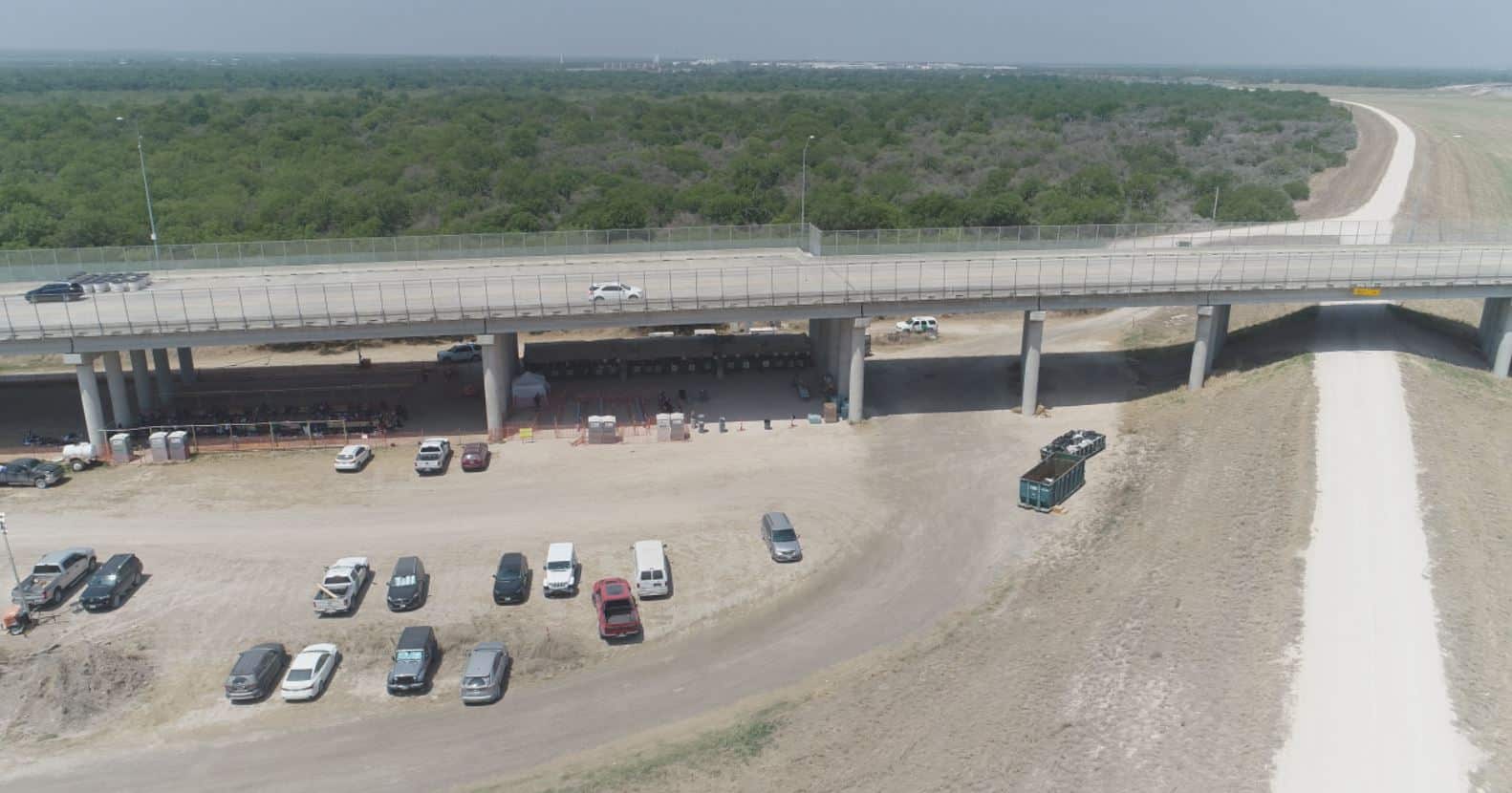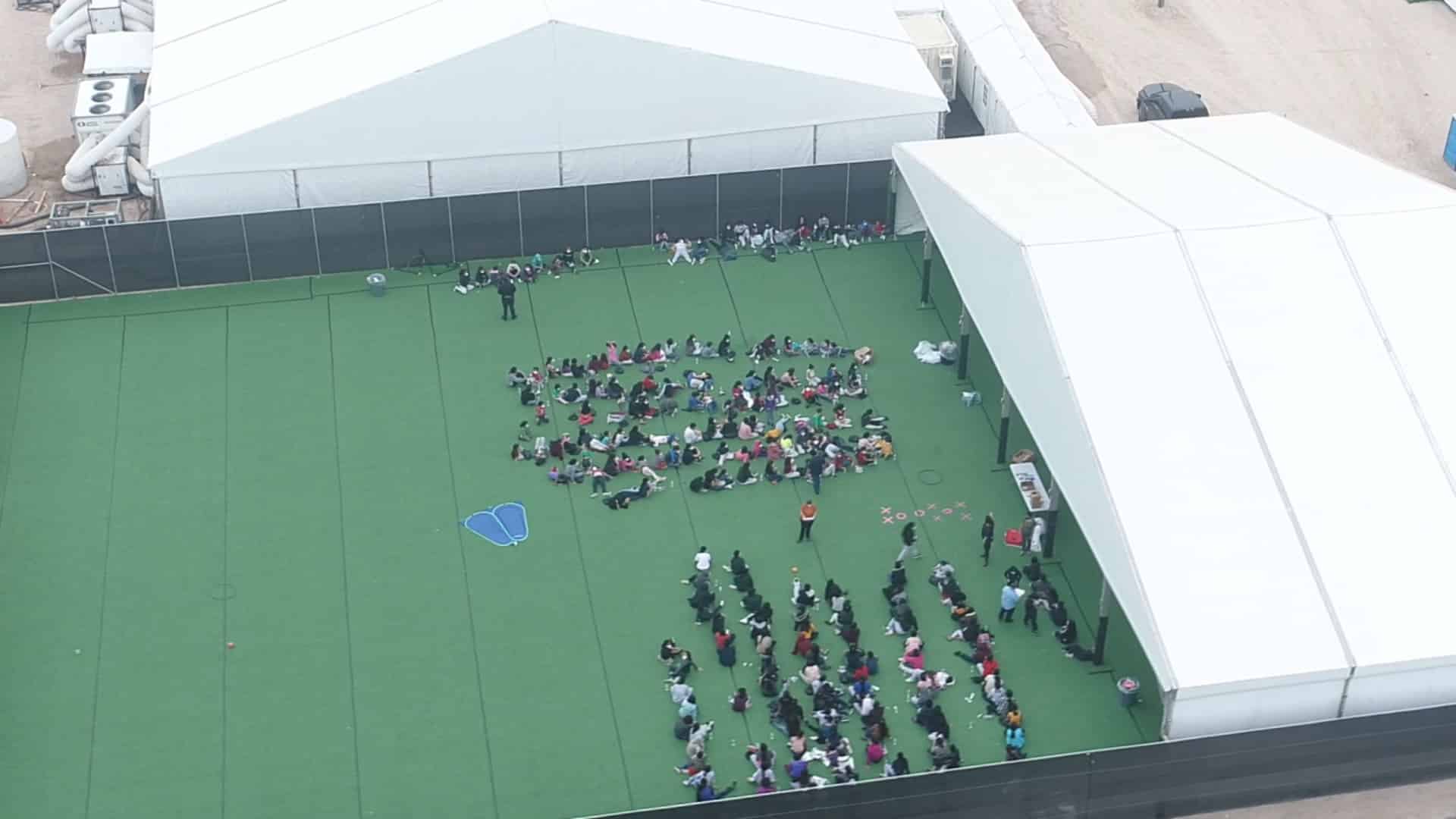Access to the migrant detention sites near Mission and Donna may be denied to the public and local news media, but a recent report filed with a federal court and drone video captured by The Monitor reveal the conditions in these highly restricted areas.
Crowded children unable to call their parents, long processing times, and looming flood threats color reports filed by the latest court-ordered inspections.
Migrants entering the country through the river near Mission are processed by Border Patrol under the shade of the Anzalduas International Bridge at a temporary outdoor processing site in Granjeno, known as TOPS. Many families later end up in Donna where they’re further processed in tents.
A court-ordered inspection succinctly articulated the problem observed by agents in the field: “The high volume of children and families entering U.S. Border Patrol custody daily, coupled with delays in the ability of Health and Human Services’ Office of Refugee Resettlement to accept custody of unaccompanied children in a timely manner, has tested the limits of RGV Sector’s capacity.”
U.S. Customs and Border Protection filed its findings last week with a federal court in California as part of the Flores Settlement Agreement, an agreement between immigrant advocates and the federal government ensuring the safety of migrant children in federal custody. It follows two similar interim reports from Jan. 15 and March 5.
Unlike the previous reports, which focused on the Weslaco Border Patrol Station and the tent site in Donna, the recent inspection focused on TOPS, a site that opened in late January.
The Monitor captured video of the restricted Donna tents and Anzalduas International Bridge sites by flying a drone overhead.

THE ANZALDUAS BRIDGE SITE
Bright orange, plastic sheet fencing cordons off a large swath of land underneath the international bridge near Granjeno to form the temporary outdoor processing area.
Wooden benches, metal stakes, small tents with window-like openings, and Border Patrol agents using bullhorns can be seen from afar guiding the lines of migrants entering from the south.
Migrants arrive there guided by Border Patrol agents they encounter after crossing the Rio Grande, or they are bused in from other stations after they’re detained.
Although the area is shaded, the site, known as TOPS, sits in a 100-year floodplain at high risk for flooding, according to FEMA flood maps. Since 2016, rain events with varying degrees of severity have been consistently leading to significant flooding in the Rio Grande Valley.
CBP received verbal permission from the International Boundary and Water Commission to set up the temporary structure, according to Lori Kuczmanski, an IBWC public affairs officer. If a storm comes, IBWC will notify the agency so it can move the structure “at a moment’s notice.”
The government’s inspector suggested the agency is aware of the threat.
“RGV Sector is exploring additional avenues to enhance conditions in anticipation of seasonal changes in weather and migrant flows,” their April 9 report stated.
About 200 children with their parents were present at the site when the government inspector visited April 7.
Meals, water, snacks, clean clothing, baby diapers, face masks, Mylar blankets, infant changing stations, portable toilets, and sinks were made available to detained migrants, the inspector observed. Facilities were cleaned every day, and spot cleaning was made available. Heaters were also available in case the temperature dropped.
All children who were present at the time were part of a family.
“Currently, this site typically processes families with children that are six years old or younger, since these families are generally not processed for expulsion to Mexico from RGV Sector,” the inspector wrote in his report.
The acting deputy agent in charge told the inspector their goal is to process families “within a shift.”
Once families are processed, those with children ages 6 and under are released into the U.S. with assistance from non-governmental organizations, or NGOs. Some are also taken to other parts of the border like Laredo or San Antonio.
Migrants whose processing is finished overnight are held at the site until morning. According to the report, “local NGOs will not accept families between 10:00 p.m. and 6:00 a.m., which may increase the time some families stay at TOPS.”
Children who arrive in the U.S. without their parents are also processed there, but they are moved to the front of the line and are usually taken to other Border Patrol stations, including the tent site in Donna.
THE DONNA SITE
The tips of white tents tower over dark-green fencing lining South Salinas Street in Donna, an area normally busy with traffic heading toward the Donna-Rio Bravo International Bridge about 5 miles away.
Now, large white buses can be seen making regular trips up and down the roadway. Those trips started Feb. 9, when U.S. Customs and Border Protection began using the 40-acre site to process migrants.
The city leased the land to CBP for $500,000 a year after the agency entered into a year-long renovation project of its largest processing center in McAllen, which closed in November. It could hold over 1,000 people before the pandemic restrictions; but after it closed, Border Patrol struggled to find enough space for the rising number of migrants in their custody.
Even with the tents, CBP continues to contend with overcrowding issues.
A CBP inspector visited the Donna Central Processing Center last week, on April 6, when the tent structure housed 83% of all children in CBP custody across the southern border.
At that time, 3,508 children were onsite. The majority came to the country without their parents.
“Given the number of individuals in custody, USBP could not maintain social distancing at the facility as originally intended,” the CBP juvenile coordinator who conducted the visit observed.
Face masks were provided to migrants and agents, and instructions were shared for proper use.
Crammed detention spaces were highlighted in pictures released late March, first by U.S. Rep. Henry Cuellar’s office and later CBP.
“The facility was over capacity, with the pods holding more than the intended number of children,” the inspector found. “However, the janitorial crews were actively cleaning the holding areas, including disinfecting the mats and cleaning the various toilets and sinks. The contracted janitorial crew cleans the pods three times per day and can spot clean an area if requested.”
On March 11, a different set of independent inspectors found that long detention times exceeding the three-day limit were caused by brimming detention space and the slow process to move children from CBP to HHS custody.
The independent monitors visited the tent site in Donna and a convention center in Dallas that receives minors from the Valley to ensure the government is in compliance with Flores Settlement Agreement standards.
“The children we interviewed at Donna had been there from five to eight days,” the report read. “Children at the Dallas Convention Center and families we spoke to subsequently reported longer stays at Donna – up to fifteen days for one child.”
Although there were about 2,100 children on site when the independent monitors visited Donna, they interviewed 18 children, including a 14-year-old mother caring for her baby.
Many detained there reported being unaware of the time of day.
“Multiple children said that the only time they saw the sky or the sun was when they went outside to a courtyard with fake grass for about fifteen minutes,” the independent monitors’ March 11 report stated. “Children said that they would go days without going to the courtyard. When they went to the courtyard, they would just sit on the ground because there was nothing for them to do there.”
Conditions may have improved later when the government inspector noted children in Donna playing with “hula hoops and balls” during his April 6 visit.
While concerns were raised about inedible food and showers at 3 a.m. with the independent monitors, the children’s main concern at the time was their inability to communicate with their family.
“None of the children I spoke to at Donna had been allowed to make a phone call to their family,” the March 11 report read. “It seemed that none of them had been given information about the sponsorship process or what would happen to them next. They were all desperate for more information.”

MOVING AHEAD
Even with the processing space, Border Patrol was overwhelmed in March when they released hundreds of migrant families without filling out standard forms that denote a pending immigration court date, as reported by The Monitor March 21.
The government’s inspector corroborated the practice.
“On March 20, due to the high-level of encounters and to alleviate the number of individuals in custody, RGV Sector began processing certain families for release without an immigration action as a matter of discretion,” he wrote. “Families released without an immigration action as a matter of discretion are released from CBP custody and informed that they are required to report to the nearest ICE office within 60 days.”
The challenges to detain and expeditiously process migrants in the Valley will likely continue to be affected by the lack of space in the sector. However, the renovation of the permanent centralized processing center in McAllen — known as the Ursula center — is expected to be complete by December.
“Absent any unforeseen challenges or delays, RGV Sector anticipates operations will resume at CPC-Ursula soon after construction is complete,” the government inspector noted in his April 9 report. “Expected enhancements include removal of chain link fencing used to create holding pods, construction of improved holding pods, new HVAC throughout the entire facility, permanent plumbing, child-friendlier interiors, upgraded security systems, and a more efficient sally port for transportation.”
Meanwhile, HHS, which is responsible for moving unaccompanied children from CBP custody into their shelters or to relatives in the U.S., is also adding facilities to increase their bed space and reducing the long waits of children in CBP custody.
On April 6, the same day the government inspector visited Donna, HHS opened a new tent structure in the space shared with CBP’s tents. The Delphi Emergency Intake Site can shelter up to 1,500 children ages 13 to 17.
Other measures to minimize the time in federal custody includes the creation of at least nine other similar large facilities across the U.S., an upcoming grant opportunity to allow licensed facilities to shelter minors, and an interagency collaboration that initiates the processing of children before the child is officially out of CBP custody.
The government inspector report found no other part of the border is facing a greater challenge addressing the “significant numbers” of migrant children and families entering the country.
“The U.S. Border Patrol Rio Grande Valley Sector is the epicenter of the current influx,” the report stated.
Inspections of these facilities will continue under the Flores Settlement Agreement terms to ensure children who are fleeing their country are met with safe conditions in a land in which they hope to find asylum.



